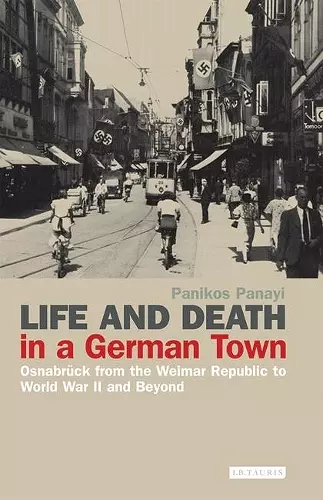Life and Death in a German Town
Osnabrück from the Weimar Republic to World War II and Beyond
Format:Hardback
Publisher:Bloomsbury Publishing PLC
Published:30th Aug '09
Currently unavailable, and unfortunately no date known when it will be back

Using primary sources, archival material and interviews, this work presents an analysis of the individual experiences of, and relationships between, various groups living in the German town of Osnabruck. It focuses on Alltagsgeschichte to understand the realities for people living in one German location in a time of great change and upheaval.
The period between 1929 and 1949 represents one of the most traumatic and destructive in the history of Germany. Economic crisis, Nazism, war, destruction and post-war dislocation dominated the lives of all Germans and those living in Germany. While all ethnic groups faced great hardship during these years, there were stark differences between the experience of native ethnic Germans, German refugees from Eastern Europe, German Jews, Romanies and foreigners. Using vital primary sources, archival material and insightful interviews, Panikos Panayi presents an extraordinary analysis of the individual experiences of, and relationships between, all these groups living in the German town of Osnabruck. He focuses on Alltagsgeschichte (the history of everyday life) to understand the realities for people living in one German location in a time of great change and upheaval. By concentrating on the wide span of 20 years of German experience he brings original breadth to an area of study, more commonly associated with the narrower focus of 1933-45. Despite the centrality of race in Nazi ideology, this is the first major study to look at the lives of all of the differing ethnic groups in Germany during this period. Panayi reveals the fluidity of the borderline between victims and perpetrators, how the use of forced labour dramatically changed the ethnic composition of the town and the impact of the arrival of German refugees from Eastern Europe at the end of World Wa II. Panayi's revealing analysis of the continuity and discontinuity in the everyday lives of Osnabruckers between 1929 and 1949, and the inter-ethnic relations during this period, is an essential reference tool for anyone wanting to understand the now time realities of living in Nazi Germany.
'The book represents a major academic achievement. It makes good use of the methodologies developed by the 'history from below' or 'microstoria' school over the past twenty years to produce fascinating case studies of a German city under Nazism, during war and in the post-war period. It is particuarly commendable that Professor Panayi goes beyond the usual end point of 1945 and seeks to combine an analysis of events during and before the war with an analysis of events thereafter. Only this way can we hope to capture the many coninuities that range from the war years into the post-war era. Under Professor Panayi's careful craftsmanship the microcosm of ethnic minorities in Osnabruck comes to life and their interactions among themselves and with the mainstream German population of that town are closely oberved. His results are meaningful far beyond the local case study and throw a revealing light on those dtamatic two post-war periods in Germany's tumultuous twentieth century. They reveal how fluid the borderline between victims and perpetrators was, how quickly perpetrators could become victims and how diverse victim groups could still be adamant on delineating their fate from that of others. Professor Panayi has produed a wonderful book which is rich in primary source material (he spent years in diverse German archives) and which has digested an enormous amount of secondary material to produce a range of original perspecties on these dark years in modern German history.' Professor Stefan Berger, Universtiy of Manchester 'Professor Panayi's research on 'Life and Death in a German Town' is a fascinating contribution to the growing field of Alltagsgeschichte...It covers all of the economic, social and political aspects of everyday realities in Osnabruck between 1929-1949...Although the town today publicises its tolerance and openness towards minorities, Panayi demonstrates that during the early part of the twentieth century, genocide became part of its history. The time scale chosen is unique in the historiography, as most studeis of this period simply focus upon the Nazi period, and, at best, bring in the immediate Weimar background. The concentration upon all ethnic groups (including the Germans) is also unique, examining experiences before, during and after the Nazi period.The aalysis of the relationships between the different ethnic groups is also an impressive innovation.' '...will be read with interest by anyone who is working on Nazi Germany, particuarly those who are interested in the everyday lives of all sections of the population, as well as anyone who is studying ethnicity, genocide and interethnic relations during the unique period under consideration.' Dr Johannes-Dieter Steinert, University of Wolverhampton
ISBN: 9781845113483
Dimensions: unknown
Weight: unknown
384 pages